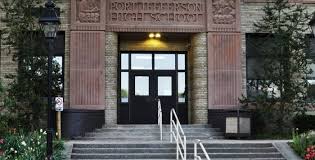Three Village Civic Association receives SBU updates

Three Village Civic Association meeting attendees received news Feb. 6 on recent developments at Stony Brook University.

Carl Mills, assistant vice president for government relations at SBU, was on hand for the meeting to provide university updates, answer questions and receive feedback from members.
Mills said it was important for the university to have a dialogue with the civic association, calling them “the voice of the community.”
He added, “From the president on down, it’s very important for us to be good neighbors and to really be a strong beacon for the community.”
Local improvements and developments
Mills informed the group that the federal government approved a grant for a pedestrian bridge that will be constructed over Nicholls Road. It would enable pedestrians to safely walk from the university’s main entrance to the hospital side and back again. Separate funds will also be used for safety and structural improvements for an existing underpass that Mills said many pedestrians don’t use because it’s further south on campus and, instead, cross the main intersection. The pedestrian bridge, with provision for cyclists, is currently in the process stage.
In April, the new Stony Brook Medicine Lake Grove facility at the Smith Haven Mall will open. He said the facility will be similar to the 500 Commack Road location in Commack. After the current roadwork by the state along Route 347, traffic concerns are not anticipated.
He said legislation passed both houses in the state Legislature last year to make Flax Pond in Old Field an estuary, but Gov. Kathy Hochul (D) asked for revisions and Mills said the bill will have to pass both houses again. The Flax Pond Marine Laboratory is operated for research purposes by SBU’s School of Marine and Atmospheric Sciences. The laboratory building and the Flax Pond Tidal Wetland Area are owned by the state Department of Environmental Conservation.
Bill A10187, sponsored by former State Assemblyman Steve Englebright (D-Setauket) and state Sen. Mario Mattera (R-St. James), establishes the tidal wetland area as a sanctuary. Initially, the intent was to amend the navigation laws to prohibit the use of motorboats within Flax Pond. Mills said with the revisions, motorboats up to 10 horsepower and certain hunting will be allowed. However, jet skiing will be prohibited as well as commercial fishing, hunting and trapping.
In conjunction with Englebright, university officials have been working to clean up and improve a parcel of land at the end of Dogwood Drive that SBU owns, near the house of 19th-century painter William Sidney Mount. Within that parcel is 635 square feet of land that belongs to a woman, who until recently, didn’t realize she owned it. The land is a gravesite where it is believed slaves and Native Americans are buried. Two of the gravestones are at the Long Island Museum and grave markers stand in their place
Englebright, who was in attendance for the civic meeting, said one gravestone is significant as a fiddle is carved into it.
“It’s also unique to have an apparent slave given this much dignity,” he said.
Many of Mount’s paintings featured musicians, including those who were enslaved.
SBU is working to acquire the property with the gravestones and also contact homeowners who have encroached on the parcel. The hope, Mills said, is to produce a documentary or podcasts about the people buried at the site.
“We’re not going to exhume the bodies but make sure that they’re protected and dignified,” he said.
State matters
SBU is one of the State University of New York’s flagship schools, along with the University at Buffalo.
“We have felt we’ve been for a long time, but that designation has profound impacts on where we can go and really what we can bring back to the local community,” Mills said.
U.S. News & World Report’s 2023 Best Colleges publication rated SBU as No. 77 nationally and No. 31 among public universities.
While SBU tuition has been flat since 2019, and it’s one of the lowest in the country, Mills said Hochul has proposed a 3% tuition increase in SUNY schools and then up to 6% for University at Albany, Binghamton University, Buffalo and SBU.
“But we look at that in the context of the fact that we have not gotten an increase in operating aid since 2012,” he said. “Since 2012, the state has funded us at the same amount to keep the lights on, to pay salaries, when all of those costs, as we all know, will increase each year.”
Last year, SBU received state capital funding due to being designated as a flagship. A new engineering building will be constructed from $100 million of funding and another $25 million will be used for a neuroAI facility that will be part of the engineering building.
“One of the big determinants of whether you’re successful as a higher education institution is how much federal research dollars you can bring in,” he said. “Stony Brook by far has the most research dollars of any SUNY campus, even more so than Buffalo, but our facilities, many of them are very, very outdated.”
He gave the example of the 1960s chemistry building where specific lab/spaces in particular need to be brought up to best practices and codes.
He said Hochul’s affordable housing proposal, which includes increasing multi-home developments by transit hubs, would affect the university the same as the community.
In her State of the State message in January, Hochul proposed a housing strategy calling for 800,000 new homes to be built in the state over the course of a decade to address the lack of affordable housing. Among the plan’s requirements would be municipalities with Metropolitan Transportation Authority railroad stations to rezone to make way for higher-density residential development. All downstate cities, towns and villages served by the MTA would have a new home creation target over three years of 3%, compared to upstate counties that would need to build 1% more new homes over the same period.
“With Stony Brook train station there’s not a lot of room, but how that plays out, will be very important to the issues that you guys care about but also for us,” he said.
Concerns by local town supervisors of planning controls possibly being taken out of their hands were noted by the audience.
Mills added, “Off-campus housing is a challenge not just for the university faculty or for students, I’m sure for you in the community to find affordable housing as well.”






